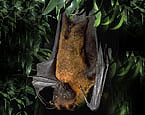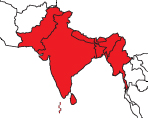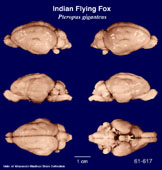|
Indian
Flying Fox
(Pteropus giganteus) #61-617 |
||||
|
|
Physical
characteristics and distribution
|
|
The average head and body length of P. giganteus is 170-406 mm. Forearm length is 85-228 mm and wingspan ranges from 610-1,700 mm. Male Pteropus giganteus weights range between 1,300 and 1,600 grams while females average 900 grams. They prefer forests or swamps, along coastal areas of islands. They roost in colonies by day, and may use the same roosting site for years. A
large body of water nearby is necessary for survival.
At night, the bats fly to neighboring fruit trees to feed.
They
mainly drink the juice of the fruit, spitting out the
pulp and seeds. They may also drink sea water for the
minerals. Pteropus giganteus is found in the Maldive Isls, India (incl. Andaman Isls), Sri Lanka, Pakistan, Bangladesh, Nepal, Burma, Tsinghai (China). (The Tsinghai record requires confirmation. Cambodian records are apparently erroneous). |
|
Description
of the brain
|
|
Animal
source and preparation
|
|
All
specimens collected followed the same preparation
and histological procedure.
|
Other
Related Resources (websites and publications)
List of Specimens | Explore Collections | Brain Sections | Brain Evolution | Brain Development | Brain Circuitry | Brain Functions | Location and Use | Related Web Sites | Contact Us | Search MSU Database | Personnel | Home


